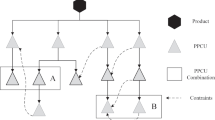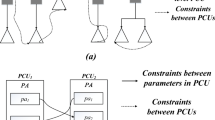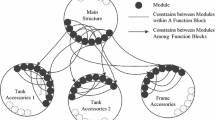Abstract
The current research of configurable product design mainly focuses on how to convert a predefined set of components into a valid set of product structures. With the scale and complexity of configurable products increasing, the interdependencies between customer demands and product structures grow up as well. The result is that existing product structures fails to satisfy the individual customer requirements and hence product variants are needed. This paper is aimed to build a bridge between customer demands and product structures in order to make demand-driven fast response design feasible. First of all, multi-hierarchical models of configurable product design are established with customer demand model, technical requirement model and product structure model. Then, the transition of multi-hierarchical models among customer demand model, technical requirement model and product structure model is solved with fuzzy analytic hierarchy process (FAHP) and the algorithm of multi-level matching. Finally, optimal structure according to the customer demands is obtained with the calculation of Euclidean distance and similarity of some cases. In practice, the configuration design of a clamping unit of injection molding machine successfully performs an optimal search strategy for the product variants with reasonable satisfaction to individual customer demands. The proposed method can automatically generate a configuration design with better alternatives for each product structures, and shorten the time of finding the configuration of a product.
Similar content being viewed by others
References
DA SILVEIRA G, BORENSTEIN D, FOGLIATTO F S. Mass customization: Literature review and research directions[J]. International Journal of Production Economics, 2001, 72(1): 1–13.
MOON S K, SHU J, SIMPSON T W, et al. A module-based service model for mass customization: service family design[J]. IIE Transactions, 2010, 43(3): 153–163.
ALPTEKINOGLU A, CORBETT C J. Mass customization vs. mass production: Variety and price competition[J]. Manufacturing Service Oper. Management, 2008, 10(2): 204–217.
TSENG M M, JIAO R J, WANG C. Design for mass personalization[J]. CIRP Annals-Manufacturing Technology, 2010, 59(1): 175–178.
OH Y, HAN S, SUH H. Mapping product structures between CAD and PDM systems using UML[J]. Computer-Aided Design, 2001, 33(7): 521–529.
GUENOV M D. Covariance structural models of the relationship between the design and customer domains[J]. Journal of Engineering Design, 2008, 19(1): 75–95.
XUE D, CHEING S Y, GU P. Configuration design considering the impact of design changes on downstream processes based upon the axiomatic design approach[J]. Journal of Engineering Design, 2006, 17(6): 487–508.
DECIU E, OSTROSI E, FERNEY M, et al. Configurable product design using multiple fuzzy models[J]. Journal of Engineering Design, 2005, 16(2): 209–233.
JIAO J, TSENG M M. Customizability analysis in design for mass customization[J]. Computer-Aided Design, 2004, 36(8): 745–757.
HONG G, XUE D, TU Y. Rapid identification of the optimal product configuration and its parameters based on customer-centric product modeling for one-of-a-kind production[J]. Computers in Industry, 2010, 61(3): 270–279.
DOBRESCU G, REICH Y. Progressive sharing of modules among product variants[J]. Computer-Aided Design, 2003, 35(9): 791–806.
LO C H, TSENG K C, CHU C H. One-Step QFD based 3D morphological charts for concept generation of product variant design[J]. Expert Systems with Applications, 2010, 37(11): 7 351–7 363.
BRONSVOORT W F, NOORT A. Multiple-view feature modelling for integral product development[J]. Computer-Aided Design, 2004, 36(10): 929–946.
JANARDANAN V K, ADITHAN M, RADHAKRISHNAN P. Collaborative product structure management for assembly modeling[J]. Computers in Industry, 2008, 59(8): 820–832.
WANG L, CHU J, WU J. Selection of optimum maintenance strategies based on a fuzzy analytic hierarchy process[J]. International Journal of Production Economics, 2007, 107(1): 151–163.
GEIST M R. Using the Delphi method to engage stakeholders: A comparison of two studies[J]. Evaluation and Program Planning, 2010, 33(2): 147–154.
Author information
Authors and Affiliations
Corresponding author
Additional information
This project is supported by National Natural Science Foundation of China(Grant Nos. 51205350, 51275459), National Science and Technology Major Project of China (Grant No. 2012ZX04010-011), and Postdoctoral Research Foundation of Zhejiang Province(Grant No. Bsh1201019)
REN Bin, born in 1981, is currently a post-doctor at Department of Mechanical Engineering, Zhejiang University, China. She received her PhD degree from Zhejiang University, China, in 2010. Her research interests include product digital design and virtual prototype simulation.
QIU Lemiao, born in 1977, is currently a lecturer at Department of Mechanical Engineering, Zhejiang University, China. He received his PhD degree from Zhejiang University, China, in 2008. His research interests include mass customization and computer integrated manufacturing system.
ZHANG Shuyou, born in 1963, is currently a distinguished professor and a PhD supervisor at Department of Mechanical Engineering, Zhejiang University, China. His research interests include computer graphics, CAD, virtual reality and manufacturing information.
TAN Jianrong, born in 1954, is an academician of Chinese Academy of Engineering at Department of Mechanical Engineering, Zhejiang University, China. His main research interests include virtual prototyping, enterprise informatization, CAX and robotics.
CHENG Jin, born in 1978, is currently an associate professor at Department of Mechanical Engineering, Zhejiang University, China. Her research interests include intelligent design of complex products, CAE for plastic injection molding, and visualization of nonlinear dynamics.
Rights and permissions
About this article
Cite this article
Ren, B., Qiu, L., Zhang, S. et al. Configurable product design considering the transition of multi-hierarchical models. Chin. J. Mech. Eng. 26, 217–224 (2013). https://doi.org/10.3901/CJME.2013.02.217
Received:
Revised:
Accepted:
Published:
Issue Date:
DOI: https://doi.org/10.3901/CJME.2013.02.217




